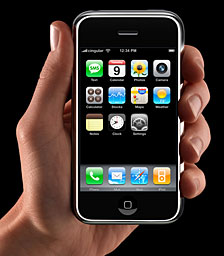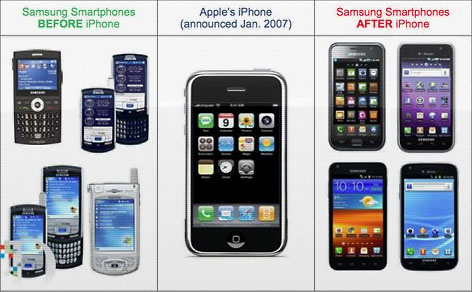Why not innovate and avoid resemblance to another company's
products? If company A has its product sold as either black or white,
why not sell your product in blue, red, or pink? If company A's product
has a patent on how to scroll, why not use a different technique or
button to work around that patent? Why mimic or copy when there is more
than one way to do the same job? (Regardless of any sensational news
story, there is always another way to do the same thing.)
As a designer of equipment and machinery, I can say that there is
nothing quicker than copying. This is true almost regardless of the
situation. I have designed a new component from scratch many times. A
rare few times, I lost or deleted a file.
The original drawing may have taken a full day to complete with all
the minor details. The replacement drawing can be redone in a few
hours. If I have a printed copy for reference, it can be completely
redrawn in less than an hour. It is the same type of difference between
coming up with the design on my own versus using a sample part to
measure and quickly check details.
Big ideas and brainstorming are the fast part of design. Translating
those concepts into a drawing and then into a part requires lots of
little details. Take a simple box: The shape is easy to visualize. Now
ask how tall, how wide, how deep, what tolerance for each dimension, is
it hollow or solid, if it is hollow then how thick are the walls, what
color, what material, how much it would cost to use that material, how
would you build it, etc. A box may be simple, but when you are done
working through all of the thousands of choices, you end up spending a
lot of time.
The saying is "the devil is in the details". Coming up with an idea
is sometimes hard, but every idea - regardless of the source - requires
work to make it a reality.
Patents used to require a working model before they were granted.
This has gone out of fashion, but an idea without implementation is
only half the job.
Some people who are not designers say that there is nothing new,
that all ideas came from somewhere else. They are ignoring the huge
importance of combining two separate ideas. The screw was nothing new.
It is just the simple combination of a wedge wrapped around a cylinder,
but together the wedge and cylinder are useful in ways that each idea
separately is not.
Combining ideas is innovation. The more surprising the combination
of ideas is, the more innovative the resulting design.
A saying that people can incorrectly use is "good artists copy,
great artists steal". It is one thing to have the skill to copy the
brush stroke of Michaelangelo. That talent would let you copy his work.
It is far harder to see into the nature of his designs, to understand
the technique, and then use the concepts to create new and different
designs. The idea that you are "stealing" is simply sensationalizing
the hard work involved.
The final element to consider when you decide if you should copy is
customer preference. When you are the innovator with the product or
design, you are the first to capture the customer's thinking. You are
implanting into the collective consciousness a model of what the
product or design should be. Once created, this picture is hard to
change.
Coke could not introduce "new Coke" without a major backlash. It
could slowly change minor details, like the switch from sugar to corn
syrup as the sweetener.
Microsoft could not switch from Windows XP to Vista without facing
tons of criticism. They could make minor changes and make Windows 7 the
success that Vista was not.
If you are going to make a change from the past, you have to provide
an equivalent exchange. Apple could drop the replaceable battery on its
laptops by providing longer battery usage instead. People are going to
resist change unless they can see the benefit. Then don't forget the
marketing campaign still required to explain the benefits to the
consumer.
The truth is you have to copy the innovator - because that is what
people want. Any changes or tweaks better have a benefit and not just
be a change to be different. The challenge is then how closely can
you copy without getting in trouble?

Tylenol's patented color scheme.
If you think that a design patent on rectangles and round corners is
bad, what about a patent on the colors red and yellow? McNeil, makers
of Tylenol, spent millions developing their gel coated product after
the "Tylenol scare". They not only patented the equipment and process
(these are utility patents),
they also patented the look (a design patent) of Extra Strength Tylenol
gelcaps. They were spending millions on advertising and consumer
preference studies for their new product. They did not want imitators
taking a free ride off their hard work.
When Granutec started selling a similar product with the nearly
identical colors, McNeil took Granutec to court. While the
manufacturing process was different, the look of the products was too
similar.
Granutec lost and had to make changes to its product.
This lawsuit had nothing to do with the active ingredient. The issue
was the look of the product, a red and yellow colored tablet, was too
similar to the innovator. Granutec even admitted it wanted its product
to look similar so the consumer would know that their product had the
same use as the innovator.
Innovative companies want no competition, and if there is any, they
want a big difference between their products. Generic companies want to
closely mimic the innovator as possible, because that has the smallest
barrier to the market.
It is easier to copy than create; even your own work is easier for
you to copy than create. Once something has become popular, there is a
cost to replace any element of the popular design with an alternate.
This is true regardless of function. A simple color change is a
barrier. The risk to getting of getting caught is a small barrier to
competition, but the challengers never stop trying.
You copy because it is the cheapest and fastest way to get on the
market. Once you get your product accepted and people recognize the
value, you can slowly make the changes to separate your product from
the innovator. The barriers to consumer acceptance are high enough that
the risk of losing a lawsuit is an accepted cost of business.
The reason there has to be lawsuits is that no one knows how closely
they can copy. Granutec did not know what shade of red and yellow would
be different enough to avoid a lawsuit. There is no law that says the
difference has to be a certain percentage. Without a specific law or
code to follow, these decisions are left for lawyers to argue and
juries to decide.
A company knowingly pursuing this course of action should establish
the proper paper trail. The design should start off as a direct copy.
Then over the course of several months and several emails, the design
is tweaked to be different, original is some small ways. This would
establish that they worked hard to be different.
Companies fail because they either underplay the risk versus the
reward or they are too focused on getting to the market. They might
fail from pride that their design is actually better. Being better does
not remove the fact that the innovator has a design patent. We can only
hope that they are not failing because of stupidity to see the danger a
lawsuit would bring.
In the end, if the damages are not too high, you win by copying. The
consumer has started to like your product. You have been smart, and you
have a plan to make the fewest changes possible to get around a
lawsuit. A little time is lost while you prepare to switch to the
changed product. Then you are back in business making money.

iPhone set the standard.
When Apple created the gold standard of smartphone design, and they
kicked BlackBerry off the throne. Every company had to begin imitating
the iPhone. Google, Samsung, etc. had little choice. It was either
imitate or be left behind.
It may have insulted Steve Jobs that Google switched to target the
iPhone. Google was showing its intelligence that the leadership role
had changed and the iPhone was the new standard. As the fast growth of
Android shows, switching the design focus from a BlackBerry-like
smartphone with a physical keyboard to the iPhone model was the better
choice.

Apple's image showing how the iPhone influenced Samsung design.
Samsung may have had other similar unreleased designs in the works
before the iPhone came out. This does not prove they did not copy. All
that matters is what kinds of phones they were releasing to market. The
iPhone made them change their decision on what kind of phone the market
wanted, and that decision was directly tied to the success of the
iPhone.
From the very day that the iPhone was introduced, Apple promised to
defend its patents. During the 2007 Macworld, Steve Jobs
said, "We filed for over 200 patents for all the inventions in
iPhone and we intend to protect them." There can be no doubt that Apple
expected to sue future challengers.
Samsung was foolish for not being better prepared.






